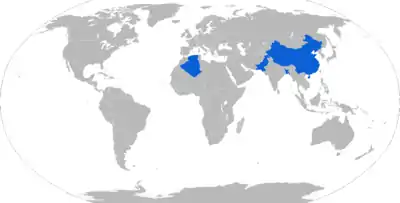HQ-7
The HQ-7 (FM-80) (Chinese: 红旗; pinyin: hóng qí, "red flag" or "red banner") is a Chinese short-range air defense missile. The missile is deployed on both ships and land-based vehicles. China revealed the export version, FM-80, in the 1989 Dubai Air Show. Unit cost is around $162,000 per launcher and $24,500 per missile.
_(cropped).jpg.webp)
Versions
HQ-7 (FM-80) Land-based
The HQ-7 SAM is used by PLA and PLAAF for short-range air-defense. At some PLAAF bases, the HQ-7 is deployed in hardened shelters. The PLA has mounted the HQ-7 on towed trailers.
A typical land-based HQ-7 battalion consists of:
- 3 x Operational Sections
- 1 x Support / Maintenance Section
Each Operational Section consists of:
- 1 x Search Unit with:
- E/F-band Doppler Search Radar (18.4 km range)
- Target processing unit, can process 30 targets & track 12 targets simultaneously
- Wired network to firing units
- IFF & radio section
- 3 x Firing Units, each with:
- Optical aiming system
- 4 x 40 kW generators
- 4-cell or 8-cell missile launcher
- J-band tracking radar (17 km range)
- TV tracking system (15 km range)
- IR localiser
- Target processing unit
- Wired network
- IFF & radio stations
Each Support/Maintenance Section consists of:
- 10 support vehicles
- Maintenance group
HQ-7 (FM-80) Self-Propelled
The 206th Institute has developed a 4x4 self-propelled version of the HQ-7. 4 x HQ-7 SAMs and a tracking radar system is mounted on a 4x4 vehicle, or towed vehicle.
HQ-7 (FM-80) Naval

The HQ-7 became PLAN's standard short-range air-defense SAM in the 1990s, and was used on new construction such as the Type 054 until superseded by the HQ-16 on the Type 054A frigate. The typical configuration is one 8-cell launcher, with stores of reload missiles in multiples of 8 (8, 16, 24). Earlier versions required manual re-loading, while later variants have an auto re-loader that can be retracted under the deck.
The Naval HQ-7 uses a Type 360S E/F-band Doppler radar with a detection range of 18.4 km, connected to the ZJK-4 (Thomson-CSF TAVITAC) combat management system. The system is capable of processing up to 30 targets, and tracking 12 targets simultaneously.
HQ-7B (FM-90)
.jpg.webp)
In 1998, the China National Precision Machinery Import and Export Corporation (CNPMIEC) produced an improved HQ-7 with faster and longer-range missiles, with an IR-tracking camera. This version received the export designation FM-90.
HQ-7 specs
- Missile dimensions:
- length - 3 m (9.8 ft)
- diameter - 0.156 m (6.1 in)
- wingspan - 0.55 m (1.8 ft)
- Launch weight: 84.5 kg (186 lb)
- Operating altitude:
- 30–5,000 m (98–16,404 ft) (HQ-7/FM-80)
- 15–6,000 m (49–19,685 ft) (FM-90)
- Minimum operating range: 500 m (HQ-7/FM-80); 700 m (FM-90)
- Max operating range:
- 8.6 km (HQ-7/FM-80, 400 m/s (Mach 1.2) target)
- 10 km (HQ-7/FM-80, 300 m/s (Mach 0.88) target)
- 12 km (HQ-7/FM-80, slow flying targets)
- 15 km (FM-90, all targets)
- Speed: Mach 2.3 (750 m/s)
- Guidance: Command + electro-optical tracking
- Warhead: HE-FRAG with proximity fuse
- Radar detecting range: 18.4 km (HQ-7/FM-80); 25 km (FM-90)
- Radar homing range: 17 km (HQ-7/FM-80); 20 km (FM-90)
Operators
